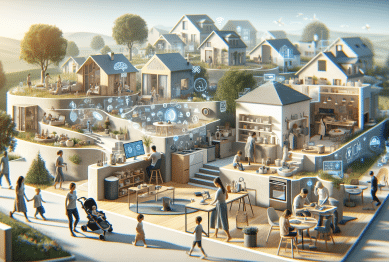Curious about the devices making modern living easier? This guide explores smart home technology trends, covering how automation, security, and interconnected systems might change everyday life. From voice assistants to energy-saving tools, discover how smart tech influences routines and what you should know about integrating it safely and effectively.
The Rise of Smart Home Automation
Smart home automation is transforming how daily life functions. With home automation, routine tasks can be done by devices, letting people save time and increase convenience. From adjusting lights remotely to scheduling thermostats, smart automation means less manual intervention for many chores. Many platforms offer compatibility with a wide range of smart home devices, making integration seamless for tech-savvy homeowners and newcomers alike. Users frequently prioritize smart lighting, automated climate control, and intuitive routines as they bring these systems into their homes. The shift toward automation is not just about convenience but also about finding new ways to manage energy and enhance quality of life.
Smart home hubs play a central role in connecting devices across the home. These hubs manage everything from controlling entertainment systems to running security cameras, often with user-friendly mobile apps. Integrated systems respond to voice commands, preset schedules, and even learning patterns of daily activity. Popular hubs may use artificial intelligence to suggest ways to improve efficiency, such as reducing energy usage during off-peak hours. For homeowners looking to optimize every aspect of their environment, understanding how to select and set up a compatible home hub is a big deal.
Interoperability is a word often heard in smart home tech. It refers to devices working together, seamlessly switching between brands and platforms. This flexibility allows owners to mix and match sensors, cameras, and appliances without being locked into a single manufacturer. Robust automation handles everything from morning routines to nighttime lighting, ensuring the environment responds to preferences. With ever-expanding options, automation platforms put users in the driver’s seat of their home experience.
Security Systems in the Connected Home
Smart security systems now protect doors, windows, and entryways using connected sensors and real-time alerts. Instead of old-school alarms, today’s setups often include video doorbells, wireless cameras, and motion detectors. These devices work together, providing constant oversight and instant notifications if anything unusual is detected. Homeowners gain peace of mind, knowing that security footage and data are available on demand, even when away from home. Some smart security providers allow remote arming, disarming, and monitoring via mobile apps to ensure that advanced protection does not compromise usability.
Integrating security technology within the broader connected home framework has changed how safety is managed. Automated routines can mimic activity while the house is empty by switching lights and appliances on and off or even simulating television or radio noise. Advanced locks, controlled by a smartphone or voice assistant, mean no more fumbling for keys. Interconnected smoke and carbon monoxide detectors send alerts directly to mobile devices, ensuring swift action can be taken at the first sign of a hazard. Combining safety features with daily convenience creates a smarter, safer space for everyone.
Privacy is a key consideration as more security devices enter the smart home ecosystem. Many systems encrypt footage and require multi-factor authentication for access, reducing the risk of unauthorized entry. Choosing providers that prioritize regular software updates and rigorous testing is strongly recommended to keep vulnerabilities minimal. When considering a new security system, investigating how providers handle data and privacy can help homeowners make more informed decisions in safeguarding both their physical and digital spaces.
Smart Speakers and Voice Assistants
Smart speakers have become household staples, acting as control centers for lights, music, weather, reminders, and more. Voice assistants such as Alexa, Google Assistant, and Siri empower users to manage devices and information hands-free. These devices can answer questions, read news aloud, and even control smart appliances, making everyday routines more intuitive. Voice control is accessible to all ages and abilities, breaking technology barriers in the home. As these assistants learn from user preferences, they become better at delivering relevant and helpful responses.
The ecosystem of smart speakers continues to expand, with new features introduced each year. Integrating voice assistants with smart thermostats and lighting offers a taste of true home automation. For instance, a single request can dim the lights, play music, and close the blinds for movie night. More advanced users script custom routines, triggering multiple actions with one command. Compatibility across device types is a major selling point for newer models, letting users invest in additional smart home gadgets with confidence.
Privacy concerns often come up with smart speakers, as always-listening microphones could raise questions. Manufacturers have responded by including stronger privacy controls, such as microphone mute switches and data access transparency. Understanding available privacy settings, from voice record deletion to device usage restrictions, provides added reassurance. As the technology gets smarter, users can choose which features and integrations suit their needs without compromising comfort or safety.
Energy Efficiency and Environmental Impact
Smart homes aren’t just about convenience—many technologies focus on saving energy and reducing environmental impact. Smart thermostats learn behavioral patterns, optimizing heating and cooling only when needed. Automated lighting ensures lights are turned off in empty rooms, contributing to lower utility bills. Even small steps, like scheduling appliances to run at off-peak times, can significantly impact overall electricity consumption. Energy monitoring plugs and analytics dashboards allow homeowners to track their consumption in real time and make adjustments accordingly.
Solar panel integration and battery backups add another layer of efficiency to the smart home ecosystem. By linking renewable energy sources to home management systems, residents can prioritize solar usage during daylight hours and store excess power for use at night. Some regions offer financial incentives for households that adopt these technologies, reducing initial costs and encouraging broader adoption. Tracking performance through smart dashboards helps optimize energy use and environmental footprint.
Users concerned with sustainability can automate more than just lighting and thermostats. Water management systems, irrigation controls, and even smart appliances with eco-modes all contribute to a greener home. By investing in devices designed for low power use, and by monitoring overall energy consumption, households can play an active role in environmental stewardship while enjoying the daily perks of advanced automation.
Smart Home Challenges and Things to Consider
Despite the advantages, several challenges arise in adopting a smart home system. Initial setup and compatibility between devices can be daunting, especially for those new to the technology. Many users face frustrations linking different brands or platforms, underscoring the importance of planning and choosing devices that support shared protocols. Look for platforms or products with solid reputations for supporting updates and integrations, easing transition as needs grow. Awareness of these compatibility issues helps prevent headaches down the road.
Security remains a top concern within the smart home sphere. Devices that connect to the internet are potential targets for hackers. Using strong passwords, enabling firewalls, and updating firmware regularly are key steps to protect smart gadgets. Choosing products with a history of regular patches and security enhancements can add another layer of safety. Homeowners should always consider the manufacturer’s privacy policy and pay attention to how personal data is stored and transmitted. Proactive strategies can make the difference between a vulnerable system and a secure one.
Cost is another consideration, as outfitting an entire home with smart devices can require significant upfront investment. On the other hand, energy savings, enhanced safety, and long-term convenience often offset these costs over time. Many residents start small, choosing one or two devices most relevant to their routine, before scaling up. By understanding the full cost—installation, maintenance, and potential upgrades—users can make choices aligned with both their budget and lifestyle goals.
The Future of Smart Living
As technology advances, new innovations continue to enter the smart home market. Artificial intelligence and machine learning will likely play larger roles, predicting homeowner needs and making recommendations for increased efficiency. Emerging standards, like Matter, aim to enhance compatibility across brands and platforms, making integration even easier. Researchers are also observing the impact of automation on energy grids and broader communities, considering how smart homes interact with sustainability initiatives and local infrastructure.
Healthcare integration represents a growing segment of the smart home. Devices monitoring vital signals, tracking sleep, or alerting caregivers to emergencies are already available. Voice assistants may someday help manage prescriptions or offer health advice based on integrated sensors. As privacy standards evolve, balancing convenience with security will remain a critical focus for manufacturers and consumers alike.
Ultimately, the future points to a more personalized and responsive home environment. Devices will anticipate routines and offer tailored experiences for each user. Whether that means managing groceries, optimizing energy use, or simply making mornings smoother, smart homes are shifting from luxury to everyday norm. Staying informed about trends and security keeps options wide open for anyone exploring the world of connected living.
References
1. U.S. Department of Energy. (n.d.). Home Automation. Retrieved from https://www.energy.gov/energysaver/home-automation
2. Federal Trade Commission. (n.d.). Home Security Systems. Retrieved from https://consumer.ftc.gov/articles/home-security-systems
3. National Renewable Energy Laboratory. (n.d.). Smart Homes and Energy Efficiency. Retrieved from https://www.nrel.gov/grid/smart-homes.html
4. Consumer Reports. (n.d.). Guide to Smart Speakers. Retrieved from https://www.consumerreports.org/electronics-computers/smart-speakers/buying-guide
5. Internet Society. (n.d.). IoT Privacy for Smart Homes. Retrieved from https://www.internetsociety.org/resources/doc/2019/internet-of-things-privacy-for-smart-homes
6. MIT OpenCourseWare. (n.d.). The Future of Smart Homes. Retrieved from https://ocw.mit.edu/courses/media-arts-and-sciences/mas-863-how-to-make-almost-anything-fall-2019/readings/the-future-of-smart-homes/









